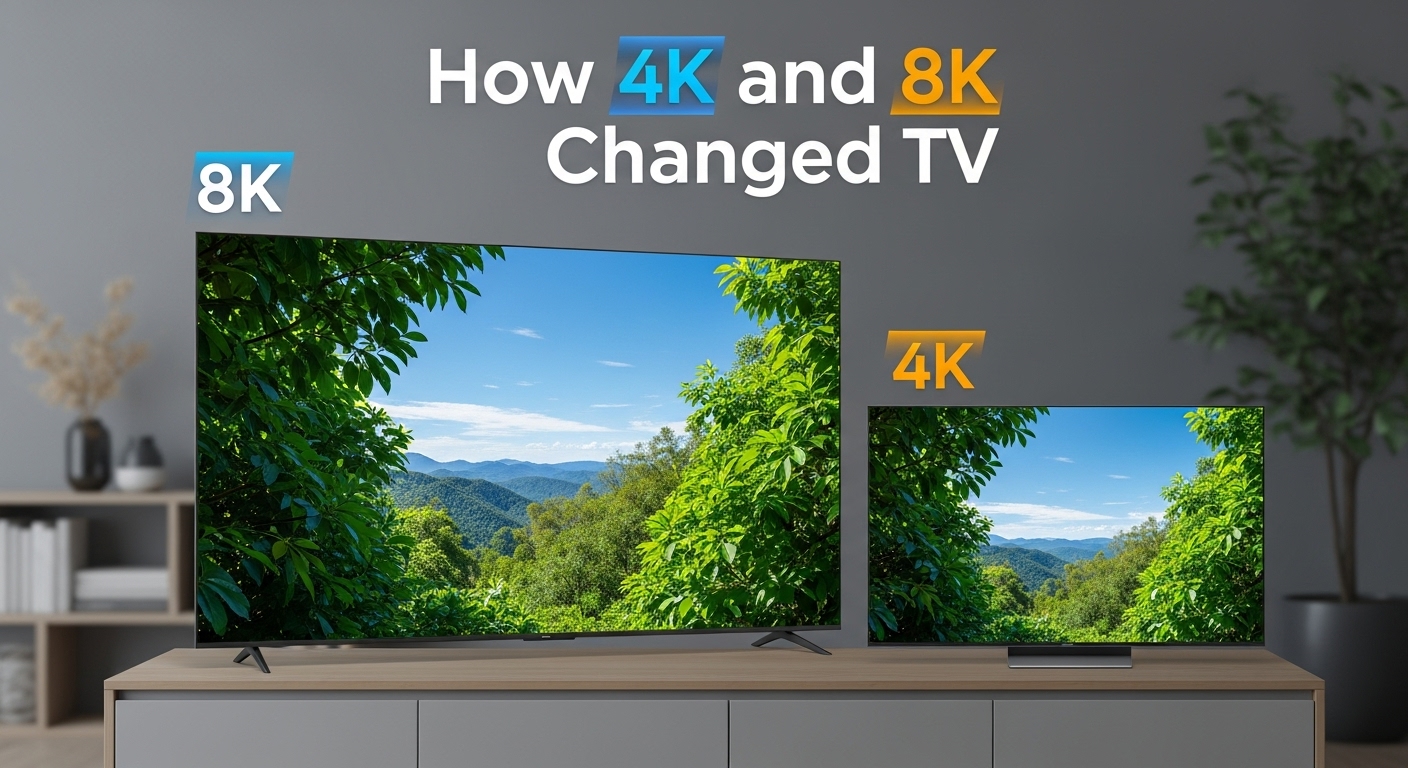Introduction to the Evolution of Television
Television has always been at the heart of home entertainment. From the black and white sets of the mid-twentieth century to the color broadcasts that followed, TV has consistently been a reflection of technological progress. Over time, the introduction of cable, satellite, and high-definition formats each redefined how audiences engaged with content. The shift from analog to digital broadcast standards further revolutionized viewing, delivering better picture quality and more channels. Yet, few transformations have had as dramatic an impact on television as the introduction of ultra-high-definition formats. The arrival of 4K and later 8K televisions has not just enhanced visual clarity but also changed the way the industry approaches production, distribution, and consumer expectations.
What 4K and 8K Mean
To understand how these formats changed television, it is necessary to first explain what they mean. 4K refers to a screen resolution of approximately 3840 by 2160 pixels. This is four times the resolution of the traditional 1080p high-definition format, hence the name 4K. The jump in pixel count brings a major improvement in detail, sharpness, and color depth. 8K doubles this once again, with an astonishing resolution of 7680 by 4320 pixels, totaling over 33 million pixels on the screen. While the difference between standard definition and high definition was already impressive, the leap to 4K and later 8K introduced a level of detail once reserved for cinema screens into the living room.
The First Wave of 4K Adoption
When 4K televisions first appeared on the market, they were considered luxury items. Their prices were high, and there was little content available that could fully utilize their potential. Many consumers wondered whether upgrading from HD was worth the investment. Over time, however, as streaming services began offering movies and shows in 4K, adoption increased significantly. Sports events, movies, and even video games started being produced with 4K as the standard. As more affordable models reached the market, 4K TVs became the default choice for new buyers. This marked a significant shift in television, where ultra-high definition went from a novelty to a mainstream expectation.
How 4K Changed Viewing Habits
The impact of 4K went far beyond sharper pictures. It changed the way people watched television. With enhanced clarity, viewers were drawn closer to the screen without losing quality, creating a more immersive experience. Cinematic details such as the texture of clothing, the subtle movements of an actor’s expression, or the intricate backgrounds in animated films suddenly became visible. For sports fans, the difference was even more striking. Watching a football match or a basketball game in 4K made the stadium atmosphere more vibrant, allowing fans to notice details like player tactics and crowd reactions that were less visible in HD broadcasts.
Content Creation and Production for 4K
For the television industry, the rise of 4K meant a complete overhaul of production standards. Cameras capable of capturing higher resolutions became essential, and editing systems had to adapt to handle larger files. Directors, cinematographers, and set designers began paying more attention to detail because imperfections could no longer be hidden by lower resolution. Makeup artists and costume designers faced new challenges since high-resolution cameras revealed everything with striking clarity. Even lighting techniques were reconsidered to ensure that productions looked natural in ultra-high definition. The shift to 4K was not just a matter of sharper screens but a transformation in how content was conceived and executed.
The Streaming Revolution in 4K
One of the major drivers of 4K adoption was the rise of streaming platforms. Services such as Netflix, Amazon Prime, and Disney+ embraced 4K as a selling point. Unlike traditional cable or satellite, streaming allowed for flexible bandwidth adjustments that made high-resolution content more accessible. Internet infrastructure improvements, particularly in broadband and fiber-optic availability, made it possible for households to stream large amounts of data required for 4K video. Streaming also introduced features such as high dynamic range, or HDR, which complemented 4K resolution by offering deeper contrasts, brighter highlights, and more realistic colors. Together, 4K and HDR reshaped what audiences expected from modern television.
The Arrival of 8K Technology
Just as 4K became a standard, the television industry began introducing 8K displays. The leap from 4K to 8K was even more dramatic in terms of pixel count, though the human eye’s ability to perceive such resolution depends on viewing distance and screen size. 8K televisions boasted stunning detail, making them especially impressive on very large screens. They represented the pinnacle of current display technology, pushing the boundaries of what a television could deliver. Yet, as with 4K in its early years, the rollout of 8K faced challenges, particularly the lack of native content.
How 8K Changed Expectations
Even with limited content, 8K televisions set new standards for what consumers believed was possible. Manufacturers promoted not only resolution but also advanced upscaling technologies that allowed HD and 4K content to look sharper on 8K screens. The presence of 8K displays in the market pushed streaming platforms, broadcasters, and game developers to consider how to adapt for the next generation of television. For consumers, buying an 8K set became a way of future-proofing their entertainment systems, signaling a shift in expectation toward continuous upgrades in visual fidelity.
Broadcast and Industry Challenges with 8K
The introduction of 8K also revealed the challenges of technological progress. Broadcasting in 8K requires enormous bandwidth, which many current infrastructure systems cannot yet support on a large scale. Streaming services face similar difficulties, as delivering 8K content means handling four times the data of 4K. Storage, distribution, and production costs are higher, making it difficult for studios and networks to embrace 8K fully. Yet, despite these obstacles, the very existence of 8K has accelerated innovation in compression technologies, network infrastructure, and hardware capabilities.
The Role of Gaming in 4K and 8K Adoption
Video games played a significant role in normalizing ultra-high-definition formats. Consoles such as the PlayStation 5 and Xbox Series X were designed to support 4K gaming, offering players stunningly detailed virtual worlds. Gaming benefits from higher resolution because of the interactivity and close-up engagement players have with screens. For competitive gamers, sharper images provide advantages in noticing details and reacting quickly. With 8K televisions, gaming potential reaches even further, allowing for hyper-realistic graphics, though hardware limitations still prevent widespread 8K gaming. Nevertheless, the gaming industry continues to push television manufacturers to innovate.
Cinematic Experiences at Home
One of the most profound ways 4K and 8K changed TV is by blurring the line between home viewing and the cinema. With such detailed images, combined with HDR and surround sound systems, households could replicate aspects of the theater experience in their living rooms. This trend became particularly significant during times when people could not go to theaters, such as during global lockdowns. Movie studios began releasing films directly to streaming platforms in 4K, and consumers embraced the chance to enjoy cinematic quality at home. The evolution of 8K suggests that home entertainment will continue moving toward theater-like immersion.
Consumer Behavior and Market Impact
The arrival of 4K and 8K has also influenced consumer behavior. Buyers now expect televisions to last longer, to be smart-enabled, and to support multiple formats. Screen sizes have grown as consumers realize that higher resolutions are best appreciated on larger displays. The demand for ultra-high-definition has also driven competition among manufacturers, reducing prices over time and making advanced technology accessible to wider markets. The television industry itself has shifted to focus on continuous innovation, knowing that consumer interest is fueled by the promise of clearer, more immersive visuals.
The Future of Resolution Beyond 8K
With 8K still gaining traction, questions remain about what comes next. Some argue that the pursuit of higher resolutions may eventually hit a limit, as the human eye can only perceive so much detail. Others believe that future innovations may focus more on improvements in color accuracy, contrast, and refresh rates rather than raw resolution. Technologies such as OLED, MicroLED, and quantum dots are already enhancing how 4K and 8K content looks, suggesting that the future may be about combining resolution with other forms of image quality. Virtual reality and augmented reality may also take cues from these advancements, applying ultra-high-definition principles to immersive media.
Cultural and Social Influence of 4K and 8K
Beyond technology, 4K and 8K have changed the cultural meaning of television. They have raised audience expectations to the point where standard definition is no longer acceptable, and even traditional high definition now feels outdated. Families gather around larger screens, streaming platforms compete to offer the best quality, and filmmakers embrace the challenge of creating visuals that impress even at the highest resolutions. This cultural shift emphasizes how television is no longer just about entertainment but also about shared experiences shaped by technology.
Conclusion
The introduction of 4K and 8K televisions has marked a significant turning point in the history of entertainment. They have redefined the standards of picture quality, changed how content is produced, influenced consumer behavior, and shaped the future of media technology. From streaming services to gaming, from cinematic experiences at home to international sports broadcasts, ultra-high-definition formats have become central to modern life. While challenges remain in terms of infrastructure and content availability, the direction is clear. Television will continue to evolve toward greater clarity, immersion, and realism. 4K established the new normal, and 8K opened the door to possibilities once unimaginable. Together, they have changed television forever, making screens not just windows into stories but vibrant, lifelike experiences that bring the world closer than ever before.



